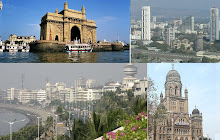

Kamathipura (also spelled Kamthipura) is Mumbai's oldest and Asia's largest red-light district. The area was set up by the British for their troops, which acted as their official "comfort zone". This small region boasted the most exotic consorts. In the 19th and early 20th centuries, a large number women and girls from continental Europe and Japan were trafficked into Kamathipura, where they worked as prostitutes servicing both British soldiers and local Indian men.[1][2] When the British left India, the Indian sex workers took over. In recent decades, large numbers of Nepalese women and girls have also been trafficked into the district as sex workers.[3]
Excerpt from the website accompanying Andrew Levine's documentary, 'The day my God died':
"I was in the middle of Kamthipura, the largest red light district in the world, and I didn’t even know it. With camera in hand, my girlfriend (who is now my wife) at my side, I was assaulted by smells and snapping away. Later I learned that every vile desire a man could dream of was for sale and child virgins were the region’s most noted delicacies."
Today, it is said that there are so many brothels in the area, that there is no space for the sex workers to sit in. They hang around in the streets, solicit customers and then rent a free bed.
The late Mr. Linganna Puttal Pujari (1915-1999), who migrated to Bombay from Nizamabad in Andhra Pradesh in the year 1928, a prominent social worker and city and state legislator, was largely responsible for most of the civic amenities available to the residents of Kamathipura today.
Some historical sources point out that the origin of slums, subsequently the red-light areas of Mumbai (previously Bombay) including Kamathipura is related to land acquisition, from the indigenous locals who were evicted from their farmlands and cattle-fields and forced themselves to live in congested conditions, for the development of the industrial harbor city. At the early stages, people accumulated in the new slums partly depended on constructions contracts. But later, as men became unemployed due to lack of job, more and more women turned up selling themselves in the red-streets of the town for livelihood. Now these streets are just playgrounds for human traffickers and mafia in addition to the economic refugees who came to these areas during the past years.
once i wnet to kamathipura for some social awarenhess programme i was really amazed and worried a lot because of the moment i saw there,one lady came to the tea shop and asked a cup of milk for her child and the shopkeeper deman 5 rs to her she told i will give later or come to my house and she went the shopkeeper really who helped me a lot to collect the detail about kamathipura and he took me to that lady's house hat was a small single bed room and she invited us her 2 year baby playing around the bed and he asked give the 5 rs she told i have no paise and come and take me for 25 rs just for 30 min and shopkeeper doesn't consider me and took her to the bed i was there and i could not come out due to heavy rain and some security purpose he an her made sx infront of me and her child after that embrasing moment i found just for her baby's milk she shared her bed oh god please take care of them

No comments:
Post a Comment